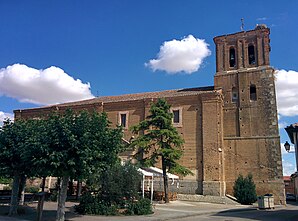Herrín de Campos
| Municipality of Herrín de Campos | ||
|---|---|---|
 Herrín de Campos - El Salvador Church
|
||
| coat of arms | Map of Spain | |
 Help on coat of arms |
|
|
| Basic data | ||
| Autonomous Community : |
|
|
| Province : | Valladolid | |
| Comarca : | Tierra de Campos | |
| Coordinates | 42 ° 7 ′ N , 4 ° 57 ′ W | |
| Height : | 775 msnm | |
| Area : | 29.49 km² | |
| Residents : | 122 (Jan. 1, 2019) | |
| Population density : | 4.14 inhabitants / km² | |
| Postal code : | 47607 | |
| Municipality number ( INE ): | 47073 | |
| administration | ||
| Website : | Herrín de Campos | |
Herrín de Campos is a northern Spanish town and municipality ( municipio ) with 122 inhabitants (as of January 1, 2019) in the northeast of the province of Valladolid in the autonomous community of Castile and León .
location
The place Herrín de Campos is located on the Río Sequillo in the center of the Comarca Tierra de Campos in the Castilian plateau at an altitude of about 775 m above sea level. d. M. The provincial capital Valladolid is located almost 70 km (driving distance) southeast; the city of Palencia is just under 50 km to the east. The climate in winter is quite cold, but in summer it is warm to hot; the sparse rainfalls (approx. 490 mm / year) fall throughout the year.
Population development
| year | 1842 | 1900 | 1950 | 2000 | 2016 |
| Residents | 631 | 872 | 617 | 205 | 130 |
The population decline in the 20th century is largely due to the mechanization of agriculture and the associated loss of jobs.
economy
The farming on the fertile clay and loess soils of the Tierra de Campos and the keeping of small livestock (especially chickens) formed the livelihood of the self-sufficient population of the region for centuries ; Horses and donkeys were kept as draft and pack animals. Since the Middle Ages, handicrafts, small trade and service companies of all kinds have developed, but have now disappeared again.
history
In pre-Roman times the region belonged to the settlement area of the Celtic tribe of the Vaccaeans ; Later came the Romans and Visigoths and in the 8th century the area was overrun by the Moors - however, none of the four cultures left any archaeologically usable traces in the formerly possibly forested area. Already in the 9th century Asturian-Leonese army conquered the areas north of the Duero back ( reconquista ) . At the end of the 10th century, the Moorish military leader Almansor temporarily wiped out the Christian successes, but in the 11th century the Kingdom of León expanded its territory again to the Duero border. After previous attempts, León finally united with the Kingdom of Castile in 1230 , but there were repeated clashes. The place experienced its heyday in the late Middle Ages and in the early modern period.
Attractions
- The Iglesia del Salvador comes from the 17th century and is built almost entirely from bricks in the old Mudéjar tradition ; only the west facade and the lower part of the bell tower show natural stone masonry. The bell storey, structured by pilasters, is completely made of bricks. The vaults of the three-aisled interior of the building are covered with a layer of stucco . The church has seven baroque altars ; the sculptures on the main altar were made by Tomás de la Sierra , who worked a lot in the region around 1700.
- Numerous storage rooms ( bodegas ) for wine and other foods such as sausages etc. have been driven into the clay slopes on the outskirts .
Web links
Individual evidence
- ↑ Cifras oficiales de población resultantes de la revisión del Padrón municipal a 1 de enero . Population statistics from the Instituto Nacional de Estadística (population update).
- ↑ Herrín de Campos - Map with altitude information
- ↑ Herrín de Campos - Climate tables
- ↑ Herrín de Campos - population development

